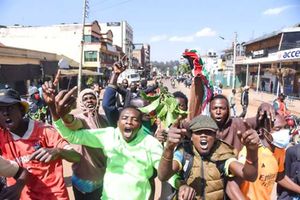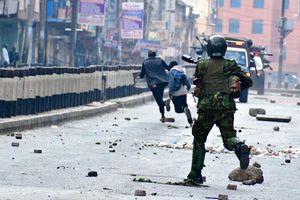
A protester sat on top of a traffic light along Kenyatta Avenue in Nairobi during demonstrations marking one year since anti-government protesters stormed Parliament on June 25, 2025.
On June 25, 2025, Kenya witnessed a powerful resurgence of youth-led protests, marking the first anniversary of the tragic June 25, 2024, demonstrations where over 60 protesters lost their lives to police brutality during the anti-Finance Bill unrest.
The protests, driven largely by youths, erupted across major cities, including Nairobi, Mombasa, Kisumu, Nakuru, and Kisii, demanding justice, accountability, and an end to systemic corruption.
The movement, amplified through social media platforms like X and TikTok, saw hashtags #SiriNiNumbers and #OccupyStatehouse2025 dominate online conversations, with #SiriNiNumbers ranking fourth among globally trending hashtags as of 8 pm on Wednesday, according to trends24, a website that tracks and displays trending topics on Twitter, both globally and within specific countries or cities.
In all, the site said the hashtag was featured in 7.7 million tweets over a six-hour period.
The protests began early in the morning, with thousands gathering at key points such as Nairobi’s Moi Avenue and Kenyatta Avenue Roundabout, as observed on social media posts.
The protesters, many carrying Kenyan flags, flowers, and candles, marched through the streets chanting slogans like “Ruto Must Go” and “Enough is Enough,” honouring the memory of those killed in June 2024.
The scale of the protests was unprecedented, with visuals capturing dense crowds moving through Nairobi’s Central Business District (CBD), undeterred by heavy police presence and barricades.
We observed posts on X underscored the movement’s resolve. For instance, a post at 12:11 PM declared, “March to the construction site on the hill,” emphasising the hashtag #SiriNiNumbers, which translates to “The Secret Is Numbers,” highlighting the power of collective action.
Another user noted “over thousands of Youths Turning out to show solidarity” in Kisii, reflecting the nationwide momentum. By 4 PM, videos and photos circulating online showed protesters near State House Girls, a secondary school just approximately 300 meters from Kenya’s State House.
The protests were not without resistance. Police deployed tear gas, water cannons, and, in some cases, live rounds were reported to be in use, leading to violent clashes. Protesters were hospitalised at Kenyatta National Hospital, many with bullet wounds.
A significant point of contention was the Kenya Communications Authority’s decision to switch off transmission signals for mainstream media stations, including NTV Kenya, Citizen TV, and KTN, a move condemned by Nation Media Group as a violation of press freedom.
A part of the statement read, “The shutdown of NTV is a direct interference with our editorial operations and a suppression of the media's constitutionally protected role to inform the public. At the time of the shutdown, NTV was responsibly covering ongoing protests, a matter of significant public interest and a constitutional right of the people to assemble and express dissent.”
By last evening, a court vacated the order by the communications authority.
"I am satisfied that they raise fundamental constitutional questions touching on potential violation of the Bill of Rights in the Constitution and freedom of the Media calling for intervention by this court," Justice Chacha Mwita said.
That the protests elicited global resonance was evident as #SiriNiNumbers trended worldwide, drawing solidarity from activists and journalists from other parts of the world.
As dusk fell, tension remained high - despite police warnings against attempts to breach protected zones like State House, online sentiment analysis indicated protesters vowed to keep the pressure on until there’s real accountability.






